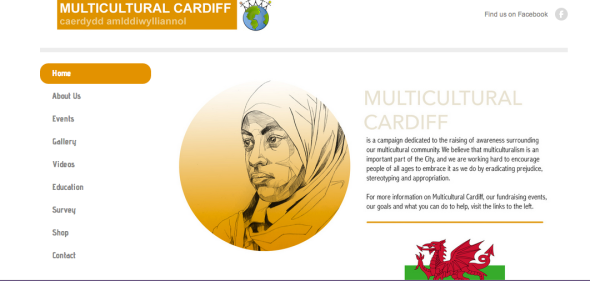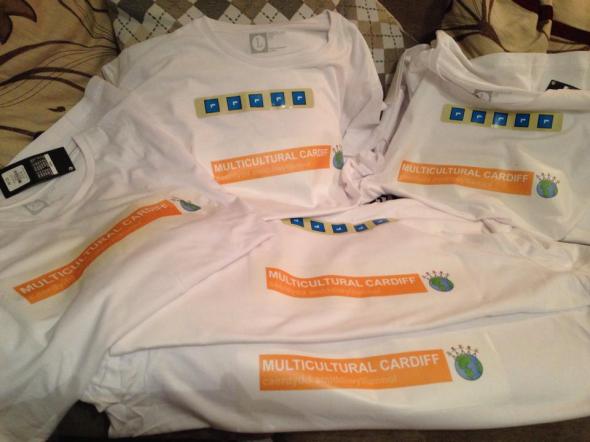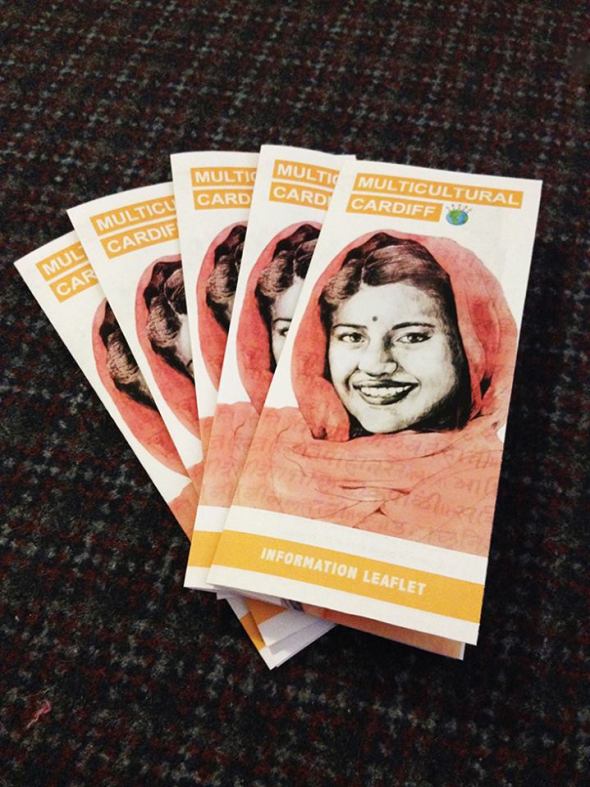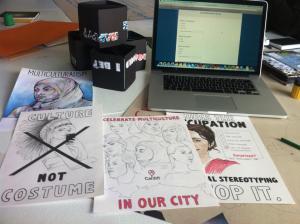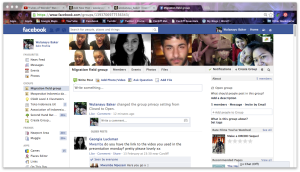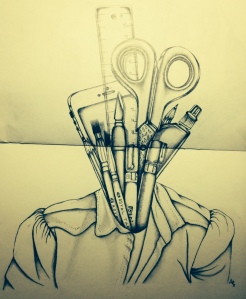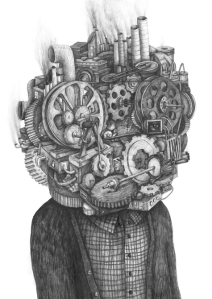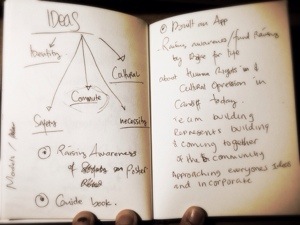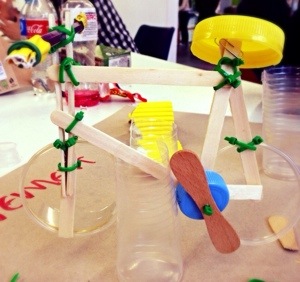Week 9 – Short reflection after group formative assessment
Posted: March 18, 2014 Filed under: Collaboration, Field Leave a commentWe gave a great presentation today. The lecturers were impressed with what we did in promoting the charity website by wearing our t-shirt product and handing out leaflets. We’ve done well and that reflected in our assessment. I’m glad that as a group, we were able to work together effectively, communicated and shared our ideas, gave constructive inputs, improved our problem solving skill, and learnt new skill from each other. Particularly with my educational box design. I’ll always keep in mind the advised that Ugur (from product design) gave me; to consider the needs of people and how the product interact with existing products, and also to consider about the sustainability of the product. These are useful tips for design planning. I also learnt about designing posters for my editorial work from Georgia and Lauren (both from illustration) which I can use for my individual project. There’s still a little bit improvement need to be done in term of the website, we need to update the logistic matter based on the feedback received from Diverse Cymru.
I remember in the first week at the group induction that I was nervous putting myself out and to work with people I didn’t know. Now I’m glad that I’ve put myself and ideas out and worked at my best, but also gained new experience and new friends through Field group project.
Week 8 – A productive week
Posted: March 15, 2014 Filed under: Collaboration, Field Leave a commentWeek 8 was a productive week, in term of working together with my field group and maybe also because it’s the last week before the final presentation. We talked about the update of our work and received good feedback from the lecturer. He wanted us to put focus on the target audience of our charity and campaign on raising awareness in multicultural Cardiff. We think that we’d like to keep the target audience to be open for public. One of the example that could explain about a broad target audience is the Cancer research charity. At first the charity aimed only at supporting women with breast cancer but in time they have expanded their target and supporter from children, men and young people as well. Further more, we emailed few charities situated in Cardiff for their feedback on our charity website. One of the charity (Diverse Cymru) gave their valuable feedback on the website. Soon after we updated the website based on their suggestions. I think now the website look more professional and well put together.
We also discussed about final presentation. The lecturer suggested that the presentation need to be insightful of our project and interactive with the viewers. We decided to produce leaflets and wear one of our charity product (t-shirt) at the presentation day. I transferred one of Lauren’s design on the t-shirts using the iron-on transfer paper. We also discussed about the main points that we would like to present on March 18th how we’re going to present our work.
Week 6 – 7: Collaboration work updates
Posted: March 9, 2014 Filed under: Collaboration, Field Leave a commentOn week 6, we presented our final proposition. It’s a website dedicated as a campaign to raise awareness in regard with multicultural Cardiff. The initial idea of the website came from Lauren Evans and we agreed on it, because we thought that it a good way to display our artwork and it’s essential to benefit from digital media and we can use it to promote, influence and hopefully will inspire change.
On week 7, unfortunately I wasn’t able to attend week 7 group tutorial because I have to interview my field-personal project research participants. However, my group have updated me that our group have received pier feedbacks. The feedbacks are good and constructive for our group development.
Child’s play
In regard with my task, I have produced a box play with the theme of raising awareness of Autism (as explained in my previous blog post about children with autism). The reason why I chose Autism awareness theme in the multiculturalism project is because I think that multi-culture is not only about celebrating the differences but it is also about learning to understand and respect of the differences and discouraging discrimination (e.g: place/country of origin, colour of our skin, education, disability, religion, political views, and e.t.c.). In this case I used discrimination suffered by children with autism as an example. I’ve seen parents struggle with looking after children with autism which got me thinking to look into types of assistance that the government have provided for the parents. I’ve noticed that a lot of the assistances or trainings are aimed at parents and not a lot that aim to young people or children. I’ve also noticed that most of the posters for autism awareness campaign ask us to respect the differences but not so much on why do we have to respect and support children with autism. Therefore based on my findings, the aim of the educational box play is to give better understanding to children about autism in school and society. A research stated that Four in 10 children with autism are being illegally excluded from school. We believe that trough education at an early age, we can influence and inspire change in the behaviour and treatment toward children with autism, which ultimately lead to adaption and respect of the differences therefore they would give support to children with autism.
According to the National Autistic Society (NAS), there is strong evidence to suggest that autism can be caused by a variety of physical factors, all of which affect brain development. There is also evidence, says the NAS, to suggest that genetic factors are responsible for some forms of autism.
Children with autism usually have difficulties with social communication, social interaction and social imagination. There is no cure for autism, however there are range of learning and development techniques interventions that are helpful. The boxes display brief definition of autism and tips on how to handle, treat, response and respect children with autism. These are the text printed on the educational box:
- It’s the difference that makes us special. Enjoy my special quirks, don’t compare me with other kids, I like being unconditionally loved and accepted because it will help me more that anything else.
- I’m not weird, I’m limited edition. Autism is a serious and lifelong developmental disability; Autism is not a mental disability problem or a learning disability; There’s no cure for autism.
- I don’t have to speak to have something to say. Pick up my nonverbal cues to be used to communicate with me, because I make sounds, facial expression, and gestures to communicate; I also have sensitivity to sound, touch, smell, taste, lights, and colour.
- Happiness is being included. Everyday life can be confusing, frightening, and lack of meaning for me therefore play is an essential part of my learning; Play when i’m awake and alert; Make me smile and laugh because we will benefits from our company.
Research source materials are from:
NHS.
Suggestion on group’s proposition
Posted: February 16, 2014 Filed under: Collaboration, Field 1 CommentOur next task as a group is to make a proposition and action plan. In connection with the group subject matter, I suggested our proposition is to present our findings and collective work to organisations that deals with multiculturalism. The work may be useful for their campaign. Here’s few possible organisations that we can approach:
- Diverse Cymru – promoting equality for all: www.diversecymru.org.uk
- Race Equality First – in connection with racism & discrimination: www.refweb.org.uk
- Bawso – support in Black Ethnic Minority: www.bawso.or.uk
The possibility of the proposition is maybe we can build a relationship in support of their campaign. Our outcomes could be influenced by their specific requests. This could be useful for our skill enhancement because we may be able to apply and use our skills for public interests.
week 5: Collective work – rough draft/design
Posted: February 16, 2014 Filed under: Collaboration, Field 1 CommentOn week 5, we’re asked to present our rough draft of the group work. In the presentation, we individually explained our tasks. Lauren and Georgia had managed to come up with four fantastic posters, Ugur set up an online survey which so far has 14 responses, and Mwamba further explained her plan for human behaviour experimentation.
We also received good feedback from our field tutors about our plans. They suggested us to decide the main focus on the multiculturalism, since it is quite a wide subject.
Pop-off cubes
In regard to my task, I have decided to target my audience to children because the pop off cubes seems to be more appealing to children than adults. The subject will be raising awareness about discrimination experienced by children with autism in school and society. The research that I have read stated that Four in 10 children with autism are being illegally excluded from school.
Link of the article: Children with autism.
I found this research finding interesting because they way the children with autism and parents have been unfairly treated by the people they trust. The parents believe and expect the teachers and society would open up and support their children no matter what, instead because of lack knowledge and understanding in handling or how to treat autism the children have suffer from discrimination. I would like to use the pop off cubes as a tool to educate children about autism. Through a better understanding, children and maybe teachers could adapt and respect each other therefore they would accept and support children with autism.
Group forum
Posted: February 16, 2014 Filed under: Collaboration, Field Leave a commentAfter an induction from field-collaboration tutors and further discussion on the subject matter (Cultural movement), the group members agreed on making an online ‘forum’ as a tool for us to discuss and share our findings (research). On February 4th, 2014, we have decided to to set up a Facebook group. We used the forum to share opinions and made final decision on our main topic which is to raise awareness in areas of multiculturalism in the city.
I shared my plan to make the pop off cubes as one of the outcomes for the project with the rest of group members through the Facebook group. I like that they are able to give opinions and inputs about my plan even though we’re not in the same room. It is also an effective tool for us to share our ideas anytime anywhere. Mwamba has also used the forum to share her ideas for experiment on human behaviour and multiculturalism relationship, Lauren and Georgia shared their research findings and their plan to make raising awareness posters, and Ugur also used it to update his task of creating online survey.
Our next plan is for each member to share their action plan of the assigned task, explain what they are planning on doing next and maybe for other members would like to give inputs and support using their particular skills. We also need to make final decision of our proposition. I personally think that the online group forum is a great tool to keep in touch, share, update and support each other therefore the outcomes of group project can be achieved.
Link to our Facebook group : Facebook group
Advantages of tolerance and freedom to live life as individuals in multicultural society
Posted: February 10, 2014 Filed under: Collaboration, Field, Individual | Tags: Migration 1 CommentI’m quite fortunate to have a subject that have close relation between Field individual and collaboration (group) projects. My individual project is about the cultural identity. I’m looking into the cross-cultural psychology which rises from migration of individuals who have developed in one cultural context when they attempt to live in a new cultural context. There is an interesting relationship arisen between cultural and behaviour, especially on the matter of importance in keeping one’s identity and characteristics. Here’s a sketch I made inspired by an artist work titled ‘Machine’ by Stefan Zsaitsits for my cultural identity project:
Whilst my field group project is about raising awareness campaign/educating societies in areas of multiculturalism. The group subject was originated from our group research on how labelling in society shapes our identity. Long ago humans has began labelling each others based on skin tone which have no truth biologically because whether “black” or “white” don’t share the exact same skin tone. However humans continued to categorise each other which lead on determining the beliefs, socio economy, geographical location, gender/transgender and political views.
Between 1975 & 2008, on average nearly 7.7 thousand people per year migrated from Wales to overseas destinations, while 7.8 thousand people migrated into Wales from overseas. Since then the numbers of international migrants moving to Wales rose by 46 percent. Cardiff alone hold the highest inward migration within the UK and highest net international inward migration from overseas compare to other cities in Wales.
As a result of migration, we are now the citizen of the world. Many societies become culturally plural. People from many cultural backgrounds come to live together in a diverse society. They form cultural groups that are not equal in power. These power difference have given rise to popular and social terms such as “Mainstream”, “Minority”, “Ethnic groups”, “Dominant” or “Non-dominant” and etc. Recognising equality, influences and changes could help balance within social class.
Advantages of multiculturalism:
- As we are exposed to other cultures, we are able to learn from them. This lead to less racism, discrimination, harassment/bullying, fewer stereotyping and victimisation because people have adapted to each other and respect each other.
- People see each other as who they are and not oh what and where they are from.
- Developing tolerance for one another which lead to acceptance which base the freedom to live life as individuals.
- Multiculturalism provides rich language, enrich innovation and creativity. Cultural celebrations such as local festivals (food, music or arts) promotes and attracts new residents and tourists to cities or local community.
- Provides trades between the cities they are living and the countries of origin.
- Broaden children’s understanding of the world and their neighbours through knowledge in school.
- Skilled migrants can open doors to investment opportunities and attract foreign investment; enhance creativity, productivity and decision-making through diverse approaches.
- Understanding global business and trade.
- Expanding consumer base.
We then made plans for the outcomes of the project:
Lauren & Georgia: To design a poster about raising awareness campaign/educating societies in areas of multiculturalism with target of the general public. Link to Georgia’s blog: http://georgialuckman.wordpress.com
Mwamba: To manage an experiment on human behaviour and its relationship with multiculturalism. Here’s a link to her experiment blog: http://mwambaa.wordpress.com/2014/02/10/field-recherche/
Ugur: to set an online survey in regard with the migration in the Cardiff city. Link to our online survey:https://survey.zohopublic.com/zs/DTDrzp
Me: to make an interactive artwork (pop off cubes) that inform about the advantages of multiculturalism. The target for the interactive cubes is children. Here’s a link of the pop off cubes in a video I made:
source materials:
Social class labelling article: http://theweek.com/article/index/243580/how-labels-like-black-and-working-class-shape-your-identity
Multiculturalism: http://www.bipt.ca/community/benefits-multiculturalism
Office of National Statistics: http://wales.gov.uk/docs/statistics/2010/101027walespopulationen.pdf
Stefan Zsaitsits: http://www.zsaitsits.com/en/drawing/2013/
Week 4: Getting to know my field group
Posted: February 3, 2014 Filed under: Collaboration, Field 3 CommentsI was a bit nervous coming to Uni for the Field – Group work today. Interacting, adapting and working together with strangers is quite challenging for me. We started the induction day by brainstorming all our initial ideas then compressed them into five main migration themes. The five themes we have are Human movement, Social/Economic, Infrastructure, Restrictions and What If?
We’re put into group based on similarity of ideas and aspirations. I’m in Human movement group. My research is about the identity of migrants in relation with cultural, personality, social and behaviour changes that the person brought into and influenced by the new environment.
The group members then negotiated and offered skills and knowledge that we have gained through individual research work. My group consist of five members. Mwamba is an illustration student who like concept art and have great presentation skill, Lauren is also an illustration student who have distinctive drawing skills and a great researcher, Georgia who is also an illustration student is very hands on, full of ideas and she also have a fantastic drawing skill and last is Ugur who is a Product design student, he is helpful and hands on creating 3D artwork.
The first group exercise is for us to come up with an artwork based on our divers ideas. Firstly we brainstormed our individual ideas (identity, people/cultural/commute/safety) then somehow combined and connected them and presented it as one idea/plan that speaks all our ideas.
Final result: We agreed on raising awareness/fund raising event poster (e.g. Bike For Life) about human rights and cultural oppression in Cardiff today. We exercised team building by creating a 3D bike model made of found objects. The bike is also to symbolise the community building within the event that we’re planning.
It was a good group work day. I’m glad that as a group, we were able to communicate and exchange our aspirations and worked together using our skills and knowledge to produce a 3D bike model.



